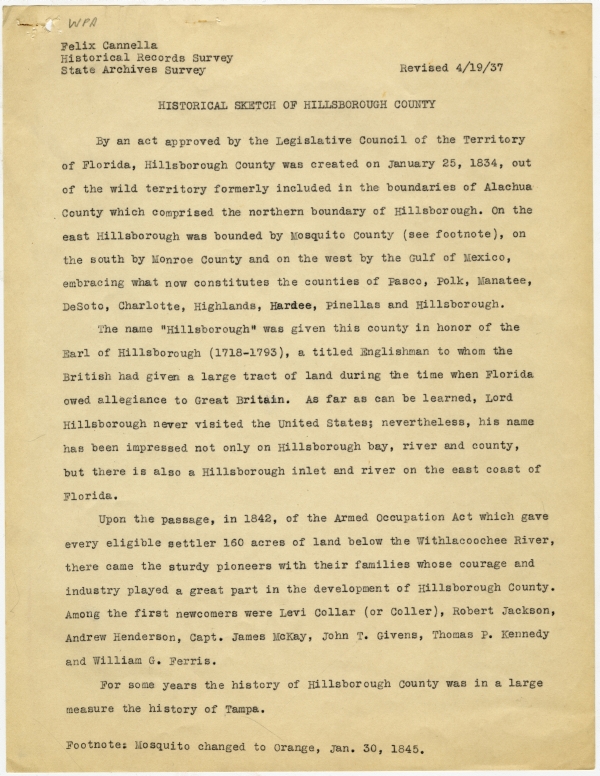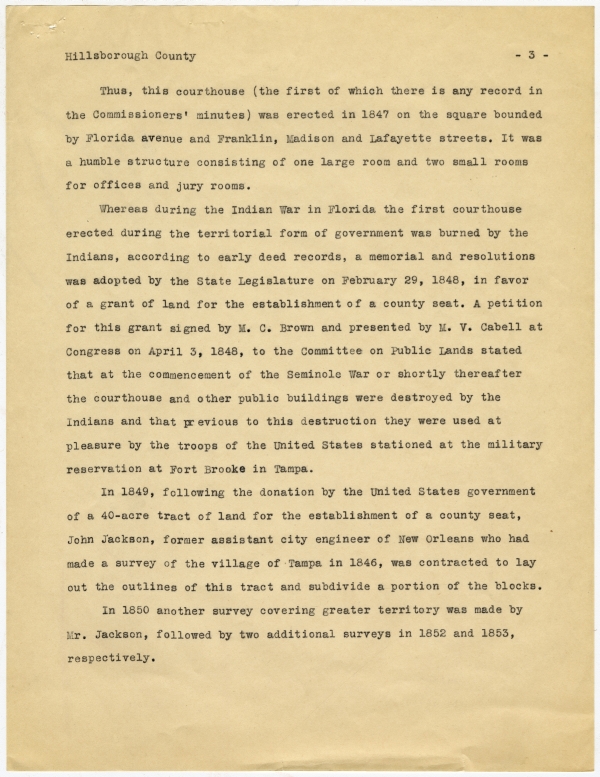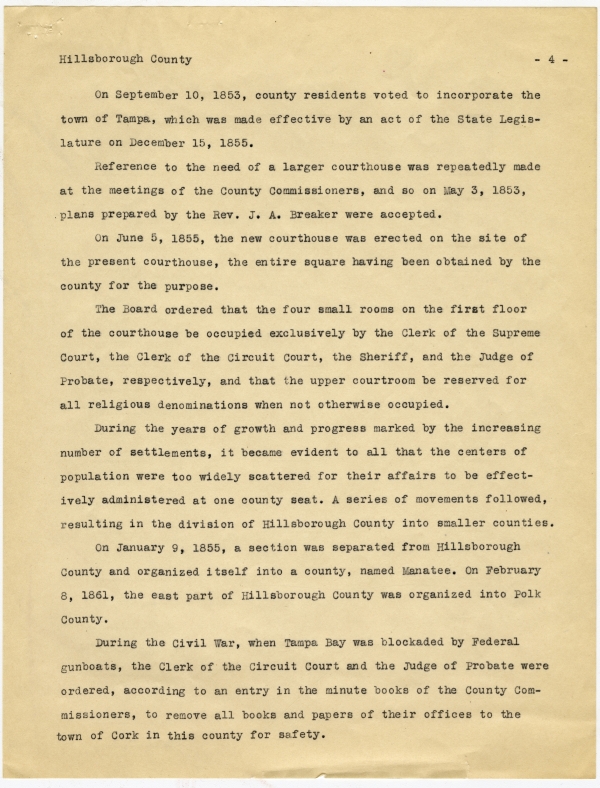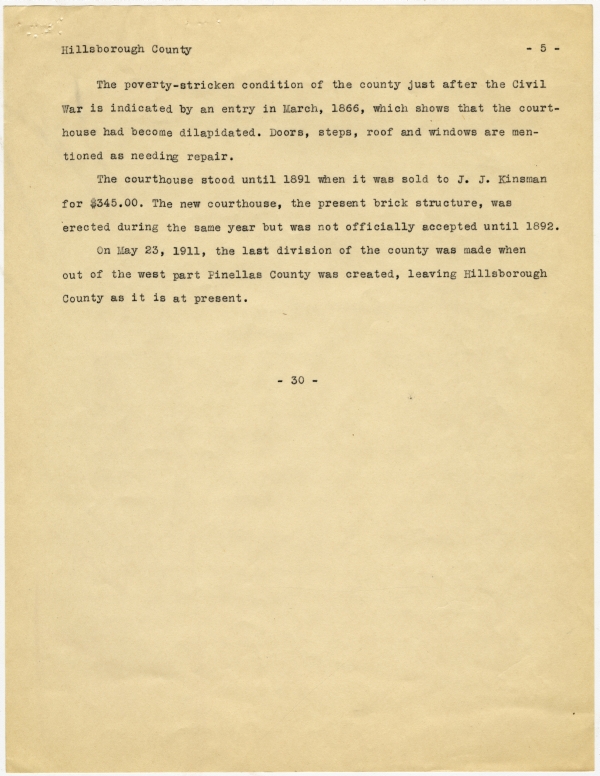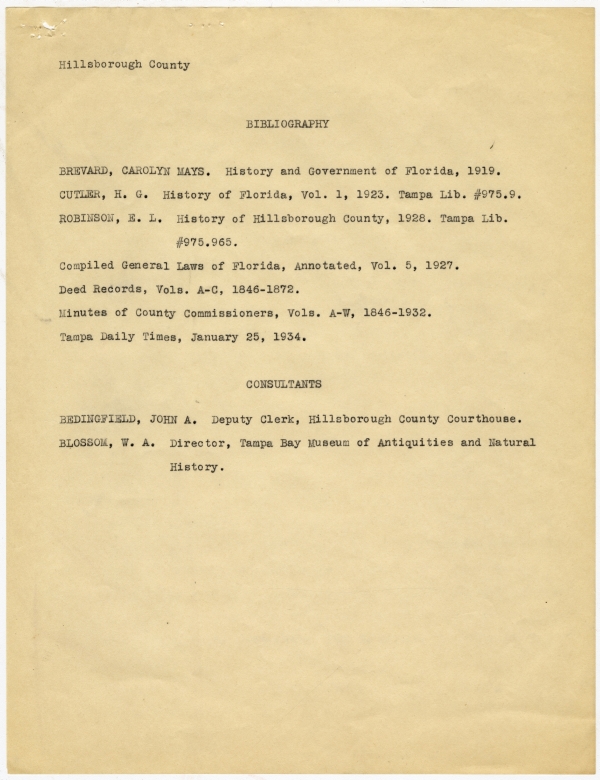Florida Memory is administered by the Florida Department of State, Division of Library and Information Services, Bureau of Archives and Records Management. The digitized records on Florida Memory come from the collections of the State Archives of Florida and the special collections of the State Library of Florida.

State Archives of Florida
- ArchivesFlorida.com
- State Archives Online Catalog
- ArchivesFlorida.com
- ArchivesFlorida.com
State Library of Florida
Related Sites
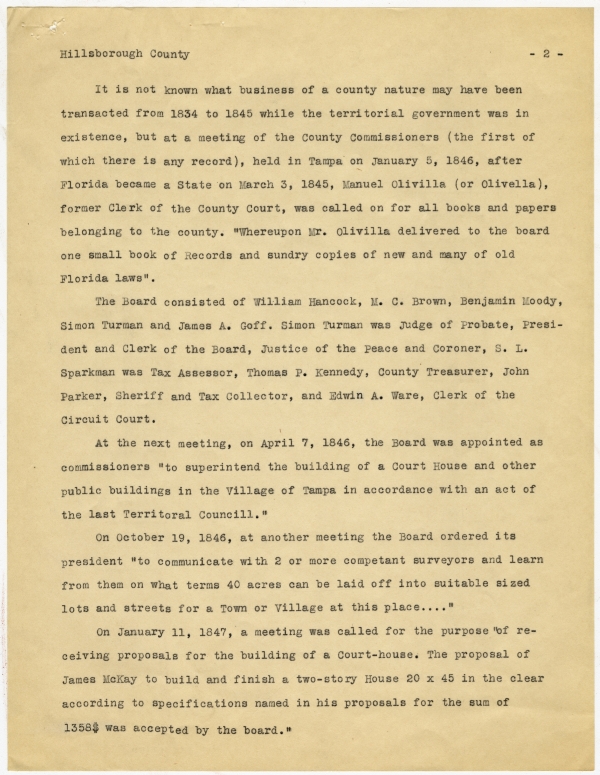
Description of previous item
Description of next item

Source
Description
Date
Contributors
Format
Coverage
Personal Subjects
Subjects
Geographic Term
Note to Researchers:
Though the WPA field workers included extensive citations for the factual information contained in these county histories, it should be noted that these historical narratives were produced in the 1930s by federal government employees, and might reflect the inherent social biases of the era.
Hillsborough County
- 2 -
It is not known what business of a county nature may have been transacted from 1834 to 1845 while the territorial government was in existence, but at a meeting of the County Commissioners (the first of which there is any record), held in Tampa on January 5, 1846, after Florida became a State on March 3, 1845, Manuel Olivilla (or Olivella), former Clerk of the County Court, was called on for all books and papers belonging to the county. "Whereupon Mr. Olivilla delivered to the board one small book of Records and sundry copies of new and many of old Florida laws".
The Board consisted of William Hancook, M. C. Brown, Benjamin Moody, Simon Turman and James A. Goff. Simon Turman was Judge of Probate, President and Clerk of the Board, Justice of the Peace and Coroner, S.L. Sparkman was Tax Assessor, Thomas P. Kennedy, County Treasurer, John Parker, Sheriff and Tax Collector, and Edwin A. Ware, Clerk of the Circuit Court.
At the next meeting, on April 7, 1846, the Board was appointed as commissioners "to superintend the building of a Court House and other public buildings in the Village of Tampa in accordance with an act of the last [Territorial Council]."
On October 19, 1846, at another meeting the Board ordered its president "to communicate with 2 or more competant surveyors and learn from them on what terms 40 acres can be laid off into suitable sized lots and streets for a Town or Village at this place...."
On January 11, 1847, a meeting was called for the purpose "of receiving proposals for the building of a Court-house. The proposal of James McKay to build and finish a two-story House 20 x 45 in the clear according to specifications named in his proposals for the sum of 1358$ [sic] was accepted by the board."
Title
Subject
Description
Creator
Source
Date
Contributor
Format
Language
Type
Identifier
Coverage
Thumbnail
Geographic Term
ImageID
Subject - Person
Transcript
Felix Cannella
Historical Records Survey
State Archives Survey
HISTORICAL SKETCH OF HILLSBOROUGH COUNTY
By an act approved by the Legislative Council of the Territory of Florida, Hillsborough County was created on January 25, 1834, out of the wild territory formerly included in the boundaries of Alachua County which comprised the northern boundary of Hillsborough. On the east Hillsborough was bounded by Mosquito County (see footnote), on the south by Monroe County and on the west by the Gulf of Mexico, embracing what now constitutes the counties of Pasco, Polk, Manatee, DeSoto, Charlotte, Highlands, Hardee, Pinellas and Hillsborough.
The name "Hillsborough" was given this county in honor of the Earl of Hillsborough (1718-1793), a titled Englishman to whom the British had given a large tract of land during the time when Florida owed allegiance to Great Britain. As far as can be learned, Lord Hillsborough never visited the United States; nevertheless, his name has been impressed not only on Hillsborough bay, river and county, but there is also a Hillsborough inlet and river on the east coast of Florida.
Upon the passage, in 1842, of the Armed Occupation Act which gave every eligible settler 160 acres of land below the Withlacoochee River, there came the sturdy pioneers with their families whose courage and industry played a great part in the development of Hillsborough County. Among the first newcomers were Levi Collar (or Coller), Robert Jackson, Andrew Henderson, Capt. James McKay, John T. Givens, Thomas P. Kennedy and William G. Ferris.
For some years the history of Hillsborough County was in a large measure the history of Tampa.
Footnote: Mosquito changed to Orange, Jan. 30, 1845.
Hillsborough County
- 2 -
It is not known what business of a county nature may have been transacted from 1834 to 1845 while the territorial government was in existence, but at a meeting of the County Commissioners (the first of which there is any record), held in Tampa on January 5, 1846, after Florida became a State on March 3, 1845, Manuel Olivilla (or Olivella), former Clerk of the County Court, was called on for all books and papers belonging to the county. "Whereupon Mr. Olivilla delivered to the board one small book of Records and sundry copies of new and many of old Florida laws".
The Board consisted of William Hancook, M. C. Brown, Benjamin Moody, Simon Turman and James A. Goff. Simon Turman was Judge of Probate, President and Clerk of the Board, Justice of the Peace and Coroner, S.L. Sparkman was Tax Assessor, Thomas P. Kennedy, County Treasurer, John Parker, Sheriff and Tax Collector, and Edwin A. Ware, Clerk of the Circuit Court.
At the next meeting, on April 7, 1846, the Board was appointed as commissioners "to superintend the building of a Court House and other public buildings in the Village of Tampa in accordance with an act of the last [Territorial Council]."
On October 19, 1846, at another meeting the Board ordered its president "to communicate with 2 or more competant surveyors and learn from them on what terms 40 acres can be laid off into suitable sized lots and streets for a Town or Village at this place...."
On January 11, 1847, a meeting was called for the purpose "of receiving proposals for the building of a Court-house. The proposal of James McKay to build and finish a two-story House 20 x 45 in the clear according to specifications named in his proposals for the sum of 1358$ [sic] was accepted by the board."
Hillsborough County
- 3 -
Thus, this courthouse (the first of which there is any record in the Commissioners' minutes) was erected in 1847 on the square bounded by Florida avenue and Franklin, Madison and Lafayette streets. It was a humble structure consisting of one large room and two small rooms for offices and jury rooms.
Whereas during the Indian War in Florida the first courthouse erected during the territorial form of government was burned by the Indians, according to early deed records, a memorial and resolutions was adopted by the State Legislature on February 29, 1848, in favor of a grant of land for the establishment of a county seat. A petition for this grant signed by M. C. Brown and presented by M. V. Cabell at Congress on April 3, 1848, to the Committee on Public Lands stated that at the commencement of the Seminole War or shortly thereafter the courthouse and other public buildings were destroyed by the Indians and that previous to this destruction they were used at pleasure by the troops of the United States stationed at the military reservation at Fort Brooke in Tampa.
In 1849, following the donation by the United States government of a 40-acre tract of land for the establishment of a county seat, John Jackson, former assistant city engineer of New Orleans who had made a survey of the village of Tampa in 1846, was contracted to lay out the outlines of this tract and subdivide a portion of the blocks.
In 1850 another survey covering greater territory was made by Mr. Jackson, followed by two additional surveys in 1852 and 1853, respectively.
Hillsborough County
- 4 -
On September 10, 1853, county residents voted to incorporate the town of Tampa, which was made effective by an act of the State Legislature on December 15, 1855.
Reference to the need of a larger courthouse was repeatedly made at the meetings of the County Commissioners, and so on May 3, 1853, plans prepared by the Rev. J. A. Breaker were accepted.
On June 5, 1855, the new courthouse was erected on the site of the present courthouse, the entire square having been obtained by the county for the purpose.
The Board ordered that the four small rooms on the first floor of the courthouse be occupied exclusively by the Clerk of the Supreme Court, the Clerk of the Circuit Court, the Sheriff, and the Judge of Probate, respectively, and that the upper courtroom be reserved for all religious denominations when not otherwise occupied.
During the years of growth and progress marked by the increasing number of settlements, it became evident to all that the centers of population were too widely scattered for their affairs to be effectively administered at one county seat. A series of movements followed, resulting in the division of Hillsborough County into smaller counties.
On January 9, 1855, a section was separated from Hillsborough County and organized itself into a county, named Manatee. On February 8, 1861, the east part of Hillsborough County was organized into Polk County.
During the Civil War, when Tampa Bay was blockaded by Federal gunboats, the Clerk of the Circuit Court and the Judge of Probate were ordered, according to an entry in the minute books of the County Commissioners, to remove all books and papers of their offices to the town of Cork in this county for safety.
Hillsborough County
- 5 -
The poverty-stricken condition of the county just after the Civil War is indicated by an entry in March, 1866, which shows that the courthouse had become dilapidated. Doors, steps, roof and windows are mentioned as needing repair.
The courthouse stood until 1891 when it was sold to J. J. Kinsman for $345.00. The new courthouse, the present brick structure, was erected during the same year but was not officially accepted until 1892.
On May 23, 1911, the last division of the county was made when out of the west part Pinellas County was created, leaving Hillsborough County as it is at present.
- 30 -
Hillsborough County
BIBLIOGRAPHY
BREVARD, CAROLYN MAYS. History and Government of Florida, 1919.
CUTLER, H. G. History of Florida, Vol. 1, 1923. Tampa Lib. #975.9.
ROBINSON, E. L. History of Hillsborough County, 1928. Tampa Lib. #975.965.
Compiled General Laws of Florida, Annotated, Vol. 5, 1927.
Deed Records, Vols. A-C, 1846-1872.
Minutes of County Commissioners, Vols. A-W, 1846-1932.
Tampa Daily Times, January 25, 1934.
CONSULTANTS
BEDINGFIELD, JOHN A. Deputy Clerk, Hillsborough County Courthouse.
BLOSSOM, W. A. Director, Tampa Bay Museum of Antiquities and Natural History.
Chicago Manual of Style
Works Progress Administration, Historical Records Survey. Historical Sketch of Hillsborough County. April 19, 1937. State Archives of Florida, Florida Memory. <https://www.floridamemory.com/items/show/321117>, accessed 19 December 2025.
MLA
Works Progress Administration, Historical Records Survey. Historical Sketch of Hillsborough County. April 19, 1937. State Archives of Florida, Florida Memory. Accessed 19 Dec. 2025.<https://www.floridamemory.com/items/show/321117>
AP Style Photo Citation
(State Archives of Florida/Works Progress Administration)

 Listen: The Assorted Selections Program
Listen: The Assorted Selections Program